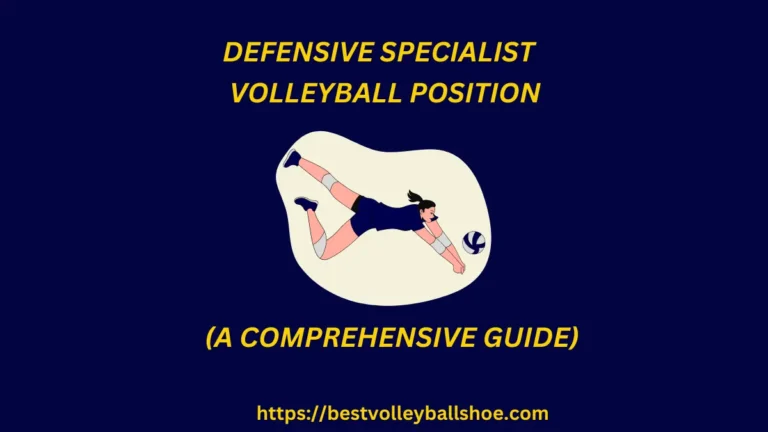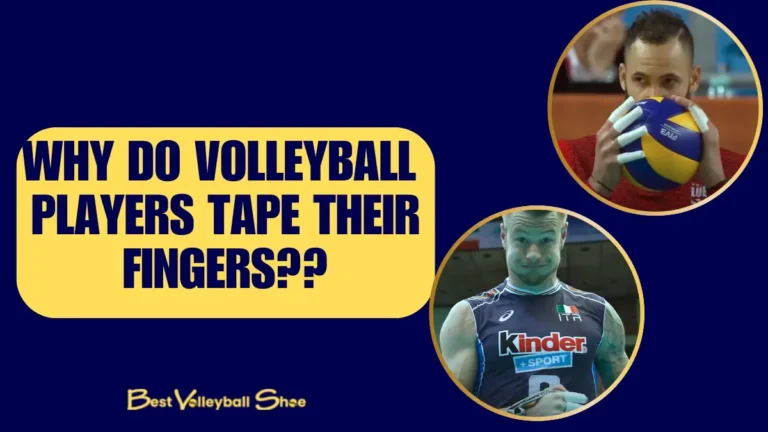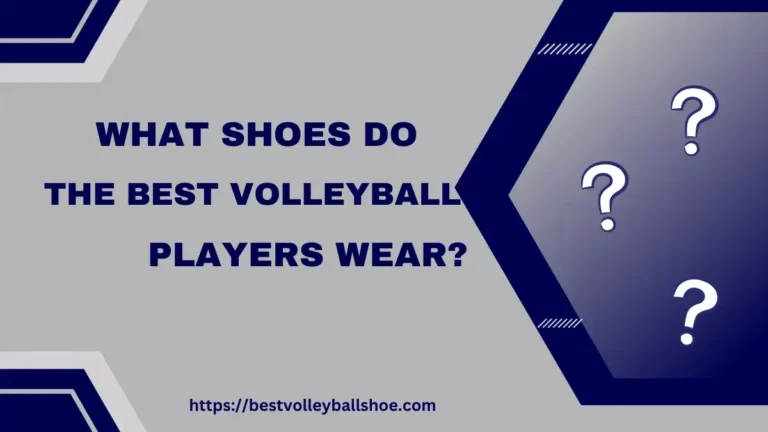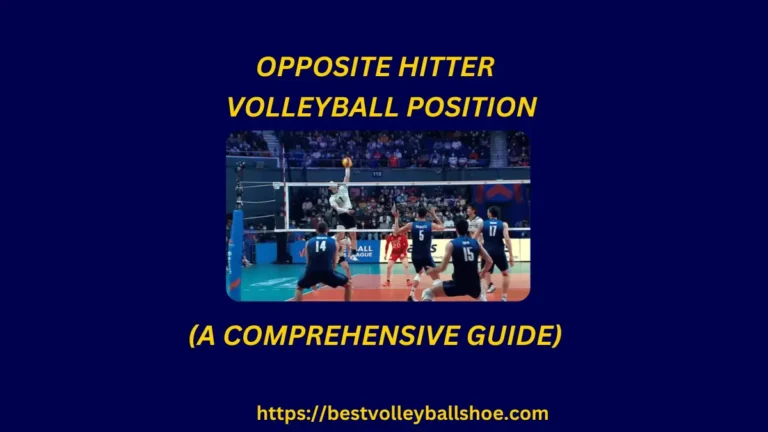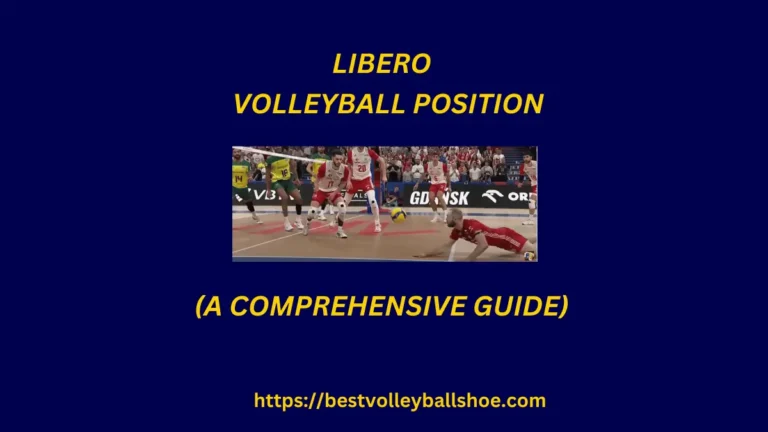Volleyball Positions: A Comprehensive Guide

Every team sport in the world, whether indoor or outdoor, has different roles for the players. These players are given special positions to effectively execute the assigned roles. Likewise, volleyball is also a team sport with different volleyball positions of players.
Volleyball is a complex sport with intricate strategic depth played on the court both indoors and outdoors. Each volleyball team comprises six players, divided into two rows: the front row and the back row.
The volleyball positions include setter, outside hitter, middle blocker, opposite hitter, libero, and defensive specialist. There is also a seventh volleyball position, i.e., serving specialist. However, few experts also regard serving specialists as a seventh position.
Usually, we have the spikers and blockers in the front row, whereas in the back row, there are defenders and servers.
The defensive and serving specialists are not very common and are seen in extraordinary circumstances.
In this article, we’ll briefly examine all volleyball positions and dissect various aspects of each.
So, let’s Start with the first volleyball position.
Volleyball Positions in the Court
In volleyball, each position on the court has designated areas where they primarily operate:
Position-1
Setters typically position themselves in either position 1 or position 2 when they are in the front court. Their main role is to set up the team’s attacks.

Position-2
Opposite Hitters: Opposite hitters, also referred to as right-side hitters, typically stick to positions 1 and 2, which are on the right side of the court. They play a crucial role in attacking from the right side and may also block.
Position-3
Middle blockers stay close to the net in positions 3 (also called the middle position) and 6 (back middle) when they are at the net. They often rotate out for the libero when in the backcourt, spending most of their time in position 3.
Position-4&5
Outside Hitters also known as left-side hitters or wing hitters, primarily operate in positions 4 and 5, which are located on the left side of the court when facing the net. They are responsible for attacking and defending from these positions.
Position-6
Libero: The libero is a specialized player who primarily plays in the 6 position, which is located in the back row. Their main responsibilities revolve around defense, passing, and serve reception, and they are not allowed to attack or block at the net.
Volleyball Positions- The Setter
The setter in volleyball holds a pivotal role as the offense nerve center of the team. Positioned ideally to receive every second ball, they shoulder substantial responsibilities that make them the linchpin of the team.
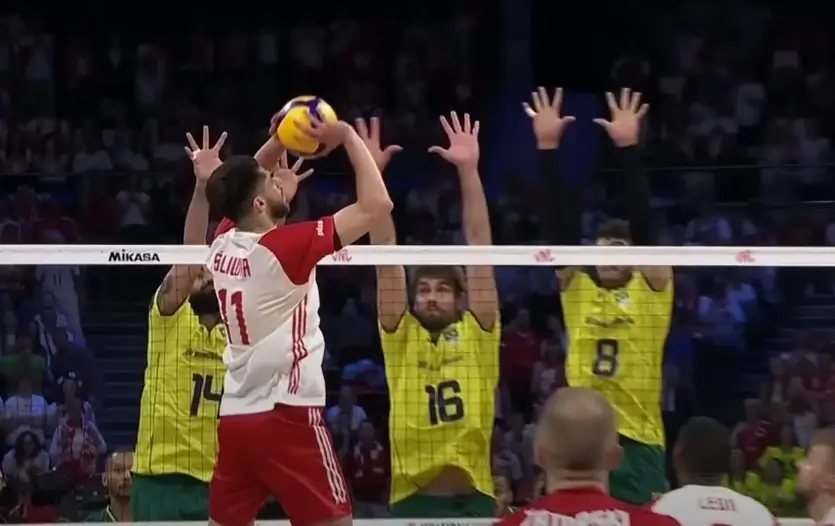
Role and Responsibilities of Setter
Setters Sets the Ball
Setters are there to receive the pass from the defenders and set it for the outside or the opposite hitters. They touch the ball more than any other player on the court.
Their sets are the decisive factors for the kill by the wing spikers; the more perfect the set is, the greater the likelihood of its being killed.
Setter Orchestrates the Offense
Beyond delivering the ball to the hitter, the setter’s responsibilities are vast and dynamic. They serve as the prime coordinator, orchestrating the team’s attacks against the opponents.
Their decisions and execution greatly influence the team’s performance, which makes the setter a cornerstone of success in volleyball.
Setter Exploits Opponent Weaknesses
The setter’s job is not only to set up plays but also to analyze the opponent’s defense, adapt strategies on the fly, and provide a crucial link between defense and offense. A good setter identifies the weak area in the opponent team and accordingly passes the ball to the right attacker.
It’s not an exaggeration to state that the setter is the most crucial player on the team, and playing this volleyball position is undoubtedly one of the toughest challenges on the court.
Qualities and Attributes of a Setter Volleyball
Leadership
Being an epicenter of offense, he must have good leadership qualities. In most of the instances, they captain the team. They act as a bridge between players and coaches as well as defense and offense.
Accuracy and Consistency
Great setters are always accurate and consistent in their sets, both in quality and quantity.
The quality set by the setter improves the hitting efficiency of the spikers.
As the setter receives every second ball on his side of the court, he has to be super consistent in setting the ball. Inconsistency may cause irreparable damage.
Height
Considering the dynamic role of the setter, height is an important physical attribute. He is the tallest volleyball player after the wing spikers and middle blockers.
A tall setter is effective at blocking lines and adds depth to the team’s blocking capabilities.
Moreover, height also helps him to reach and set the higher ball with more advantage.
Agility
Agility is of prime importance to the setter. He won’t be served with the pass like a cooked dish every time. Rather, he has to quickly convert a distant and awkward dig into a quality set, which will be impossible if he lacks agility.
Strength
Arms and wrist strength are important to set the ball at optimal height and speed. Weaker arms or wrists are the inhibitors of setter performance.
For details read a complete article on The Setter Volleyball Position
Volleyball Positions –The Middle Blockers
The middle-blocker, the primary line of defense, is normally the tallest volleyball player on the team.
Playing in the front row, he also acts as a middle hitter in a volleyball team. They are also known as middle hitters or middles.
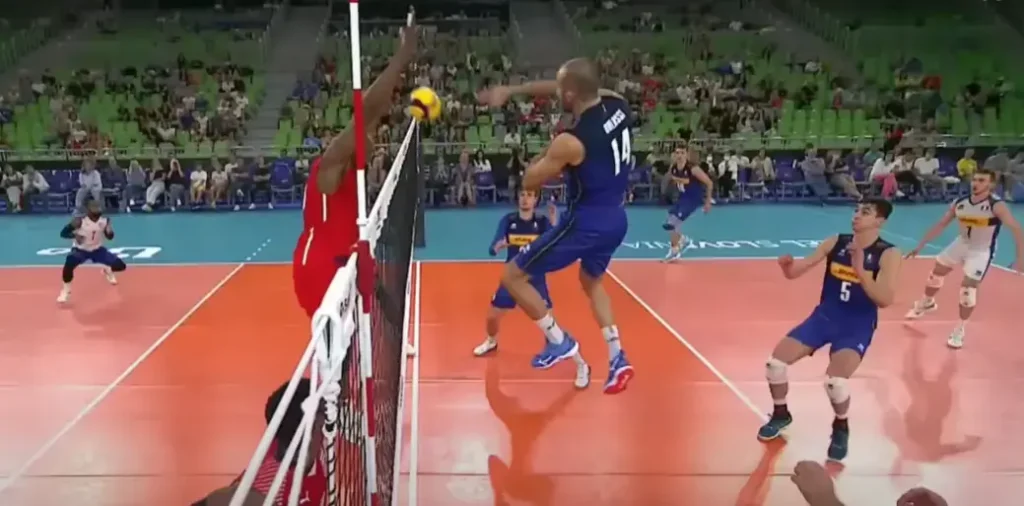
Role and Responsibilities of MB
Middle Blockers are the Primary Blockers
The primary job of the middle blocker is to perform defensive responsibilities by acting as a human wall at the net. They are there to judge the movements and block the spikes from the opponent team’s spikers.
In an ideal situation, each spike and quick attack from the opponent team spikers should be a middle blocker. However, this is not the case in the actual play.
Hitting the Quick Sets
A Middle blocker also possesses hitting capabilities and responsibilities. They perform quick attacks on the net because of their proximity to the setters.
Serving
After rotation to the backcourt, the setter also serves the ball. Their strong serves make a great difference.
Qualities and Attributes
Height
Middles are the tallest players in a volleyball team. It is due to the nature of the job; you have to reach earlier and at an appropriate height to block. A shorter middle blocker will be unable to intercept the spike and block it.
Arms Strength
Arms strength is important for the middle blocker due to his hitting responsibility. Arms strength is important to punish the ball with power and speed.
Arms Length
Arms length is essential for standing reach. Middle blockers with lengthy arms take less time to reach and cross the net blocking height.
Observation
Observation helps the middle blocker to judge the ball’s direction, height, and speed. Moreover, it also hints at the offensive and defensive strategy of the opponent team.
Volleyball Positions–The Outside Hitter
The outside hitter or the left-side hitter, the attack specialist, is considered the point-scoring machine in a volleyball team.
Like the setter gets more passes than any other volleyball player, the outside hitter gets more sets in a match.
They are the strongest and most talented spikers, as well as among the tallest players on the team. High jumps and hard-hitting are the key characteristics of a good volleyball outside hitter.
It is also one of the toughest Volleyball positions on the court.

Role and Responsibilities of OH
Outsides are the Primary Hitters
The Primary responsibility of the hitters is to swing their arms and shake the opponent’s side of the court with their exceptionally powerful spikes.
Outside also block
In the front zone of the volleyball court, outside is also responsible for blocking when the opponent spikers are at business.
Outside’s Serves is a Test of the Opponent’s Defense
The outside hitter, while rotating to the backcourt, is responsible for serving and digging the ball like any other player, except libero, who is there to dig and pass. Their powerful serve is the test for the opponent’s defense.
Outside Assist the Libero in Passing
He assists the libero in receiving service and is equally important. Normally, the best outside hitters are exceptional at passing.
Qualities and Attributes
Agility and Strengths
They are quick in their movements and strong with arms to hammer the ball into the opponent’s side of the court.
Height and Verticle Jump
Outsides are decently tall with a substantial vertical jump. They are the third tallest player in the team after middles and opposites.
Hand-eye coordination
They have good hand-eye coordination for a quick reaction after judging the tricky balls like tipping, dumping, or cutting.
Volleyball Positions: The Opposite Hitter
The Opposite Hitter is one of the best volleyball positions. They are the valued and dominant spiking asset of the team.
They are also known as the right-side hitters as they play on the right side of the court.
They are the second-tallest players on a volleyball court. Like outside hitters, they are also responsible for hitting and blocking.
Considering the primary role of spiking, they are similar to the outside hitter but different in other responsibilities.
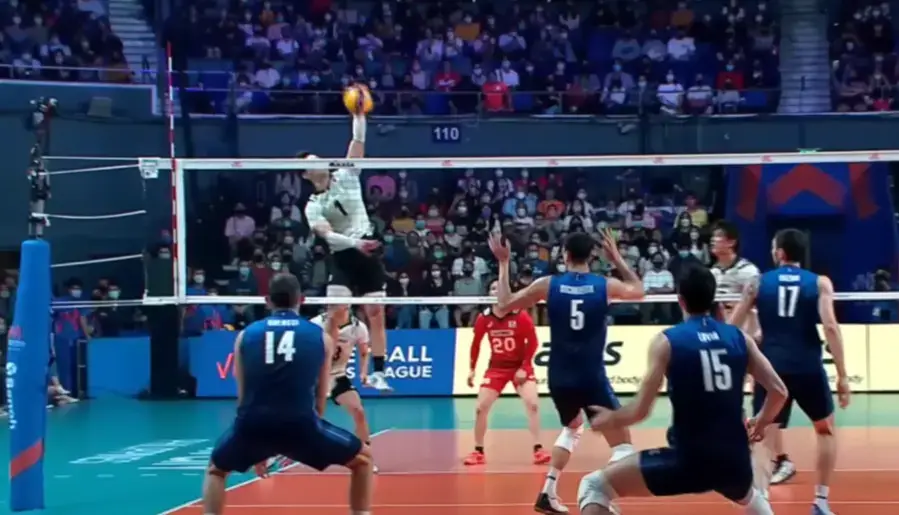
Role and Responsibilities of OPP
Opposite Hitter
Like any other player except libero, they’re also responsible for serving. Effective serve is essential to put the opponent under pressure.
Opposite Hitters also acts as a setter
They are also in the court to set the ball in the absence of the setter.
Back Row Spiking
Opposite hitters are excellent at spiking from the back row. A renowned example of this is the Yugi Nishida of Japan.
Opposite also Blocks
They are one of the three blockers in the front row, along with the middle blocker and outside hitter. They usually block from position 02 on the right side of the middle blocker.
This volleyball position demands excellent blocking skills and technique as they have to block the primary spiker of the opponent team, i.e., outside hitter.
Qualities and Attributes of OPP
Strength and Athleticism
The right-side hitter has to spike from the backcourt, so they have to be strong and athletic. Spiking from the back row is a tough job, as it requires skill and power to hit the ball at a decent speed to the opponent’s court.
Height
Height is an important physical attribute for all volleyball positions except libero. But it is a critical physical attribute for an opposite hitter. They are usually the second-tallest player after the middle blocker.
Volleyball Positions: The Libero
Libero is one of the defense-specialized back-row volleyball positions. They can be replaced by the same player it replaces and also sub in and out freely. They wear different colored jerseys to make them distinguished on the court.
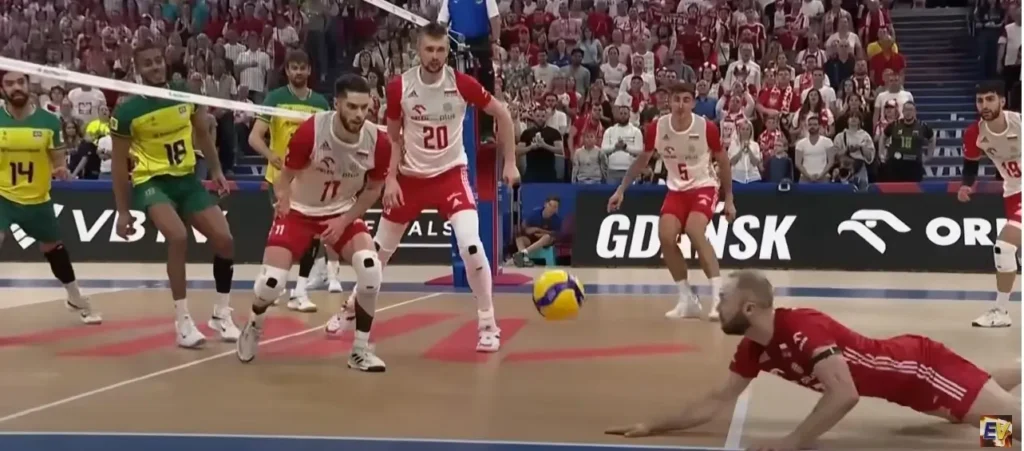
Role and Responsibilities of Libero
Outstanding Passing and Digging
Liberos are responsible for keeping the ball off the floor. Their job is contrary to the attackers, whose prime objective is to put the ball on the floor. In the competition of dig and kill, the great liberos are master at frustrating the spikers with their quality digs.
Liberos passes to the setter are precise and accurate, which greatly impacts the quality of the set.
Liberos also set
If the setter is unable to reach the ball, it is the libero who has to set the ball for the spiker, but this is not very common.
Serving as the vocal leader in the backcourt,
Liberos are the captain and vocal in the back row. They orchestrate communication, setting an example for effort and tenacity.
Leading by example, they dive for balls, sacrifice their body, and ensure consistent execution.
They also manage their role of digging and passing by their excellent communication. For instance, if they are unable to reach a ball, they might call upon the nearest player to make the pass or dig.
Commitment
The libero’s commitment on the court to digging and reaching the tough ball is second to none.
Qualities and Attributes
Liberos are the Usain Bolt of the Court
Liberos are quick in diving and reaching the ball in split seconds. It’s like they have a secret turbo mode button giving them a sudden thrust like a jet.
Short Highted
They are the shortest players in a volleyball team. Short height is the game’s demand as they have to dig the ball and make quick movements. Short height facilitates their movement during digging and diving.
Flexibility
Flexibility is an important physical attribute of a libero to make difficult movements. Moreover, it also helps them avoid injuries.
Volleyball Positions: The Defensive Specialist
A defensive specialist (DS) is a special player in volleyball positions who’s really good at defense. They don’t have one of the usual five positions, and you don’t see them on the court as often.
But when the team needs some extra help with defense and passing, the defensive specialist can come onto the court.
A defensive specialist is great at digging the ball (like saving it from hitting the ground) and passing it accurately. They’re like the defense experts of the team.
What’s cool is that they can be any kind of volleyball player, like an outside hitter, opposite hitter, or middle blocker. They’re flexible that way.
Here’s when they usually come into the game:
- They replace players who aren’t as good at defending in the back part of the court.
- They help the team by making sure the other team doesn’t score points easily.
- When the players who usually stay near the net move to the back of the court, the defensive specialist can replace them.
Qualities and Attributes
Delivering Under Pressure
A Defensive Specialist (DS) is like a clutch player in volleyball. When the score is super close, they’re the ones who come in. So, they have to stay calm and do well even when things are tense.
Accuracy and Agility
Accuracy is a big deal for a DS. They need to make really precise passes to help their team. Think of it like passing the ball exactly where it needs to go. Also, they must be quick on their feet and move around the court quickly.
Scramble Defensive Plays
DS players need to be great at making quick and tricky defensive plays. Picture them diving to save the ball from hitting the ground. It’s like being a superhero on the court, saving the day.
Efficient Court Coverage
They also have to be smart about covering the court. It means they need to be in the right place at the right time to stop the other team from scoring. It’s like being a goalie in soccer but in volleyball.
Volleyball Positions: The Serving Specialist
In volleyball, some people say there are seven positions, but most folks agree that there are either six or seven positions on a team.
Now, here’s the interesting part: sometimes, there’s this rare player known as a “serving specialist.” This player doesn’t play the entire game; they’re mainly there for their incredible serving skills.
The Incredible Serve helps in winning points as
- It may land in a space where the opponent’s defense can’t even touch the ball.
- It may affect the quality of the set as the serve reception determines the Setting Efficacy.
Picture this scenario: your team is at match point, and the opponent team is one point behind you. The opponent team has a strong defense and a powerful attacker ready to score. Unfortunately, the player who’s about to serve for your team isn’t very good at it.
But on your bench, you’ve got someone who’s known for their fantastic serves. In this moment, you might sub them into the game to serve, and once they’re done, you swap them out of the rotation.
Here’s the thing, though: serving specialists are quite rare, and you’re more likely to spot a unicorn than one of them on a regular volleyball court! They’re more common in international or professional-level play.
Volleyball Positions FAQs
What are the common gears for all volleyball positions?
The common gear for all volleyball positions includes volleyball shoes, knee pads, and elbow pads. The most important of these all are the volleyball shoes. Check my article on the best volleyball shoes for a better understanding.
What is the best position to Play in volleyball?
Talking about the best volleyball positions, I think it depends on the skill set, physical attributes, and the personal likes and dislikes of any player.
If someone enjoys the movement of frustration on the opponent’s spikers after digging their spike then he should be a Libero. On the other hand, if somebody likes to swing his arms and likes to shatter the other side of the court then an Outside hitter is best.
Moreover, if someone has leadership qualities then he should go for the setter volleyball position.
If someone, is short-weighted then libero is best for him but if he is tall then hitting position will suit him the best.
What is the hardest volleyball position?
The setter is regarded as the toughest of all volleyball positions to play. This is because of the setter’s role in running the team offense and providing leadership.
They act as a bridge between the offense and defense. They are the nucleus of communication, directing and guiding the wing spikers and other players about the play on the court. They also captain the team and convey the instructions of the coach to players.
What are the shortest and tallest volleyball positions?
In volleyball, the middle blocker position is generally associated with tall players, often making them the tallest volleyball player. However, there can be exceptions to this general trend.
It’s not uncommon to encounter opposite hitters who are exceptionally tall, sometimes even taller than the middle blocker. This variance in player height showcases the diversity and adaptability of volleyball teams.
Nevertheless, it remains a common pattern that the libero, due to their specialized role in defense and passing, tends to be one of the shortest players on the court. Overall, volleyball teams can exhibit a range of heights within different positions, reflecting the unique skills and attributes of each player.
What are the most important volleyball positions?
Although the role of every member is equally important, yet being the vocal and the advisor for the teammates setters and libero are the most important players. The libero saves the point by digging a tough short on the other hand setter creates an opportunity by passing the ball to the right hitter.
What volleyball position wears a different jersey?
Volleyball libero stands out from the rest of the team by wearing a distinctively colored jersey. This unique jersey helps both the referees and players easily identify the libero on the court.
Furthermore, the libero is restricted to playing in the back row and is not permitted to spike or attack the ball above the net. These rules are in place to maintain the libero’s specialized role as a defensive and passing specialist, and the different jersey color serves as a visual cue to remind everyone of these limitations during play.
What volleyball positions serve in volleyball?
In volleyball, all volleyball positions except the libero are typically required to serve the ball. However, it’s pertinent to mention here that under USA volleyball rules, there is a provision that allows the libero to serve in one rotation, although this is not a common occurrence.
Contrarily, European volleyball rules generally do not permit the libero to serve. The libero’s primary role in both regions is to excel in defense and passing, but rule variations can influence whether they are allowed to serve during a match.
What are the best volleyball positions for tall players?
Tall players in volleyball often find their best fit in the positions of middle blocker and opposite hitter. These volleyball positions emphasize blocking over passing, making height a crucial advantage.
Normally, opposite hitters and middle blockers are taller than players in other positions on the court, with middle blockers often being the tallest among them. Their height advantage is particularly valuable for effectively blocking the opposing team’s attacks and making strong offensive plays at the net.
What are the hitting positions in volleyball?
In volleyball, the primary hitting positions are the outside hitter, opposite hitter, and middle blocker. Among these positions, the outside hitter typically gets more opportunities to attack the ball than the opposite hitter, with the middle blocker following closely behind in terms of hitting opportunities.
In some cases, the setter may also take a swing at the ball if they are in the front row. It’s important to note that the libero, a specialized defensive player, is the only position on the team that is not allowed to participate in hitting or attacking the ball. Their main role is to excel in digging and passing to facilitate the team’s offense.
What does OH & OPP mean in volleyball?
“OH” stands for “outside hitter,” which is a player positioned on the left or right side of the front row. They are responsible for both attacking and defending from the sides of the net.
On the other hand, “OPP” refers to the “opposite hitter,” who is positioned opposite the setter in the front row. The opposite hitter plays a vital role in attacking and blocking, often acting as the team’s secondary or backup attacker.
What does MH refer to in volleyball?
Sometimes, people use the term “middle hitter” interchangeably with “middle blocker,” so when you see “MH,” it essentially means the same thing as “MB.” Both refer to the player who occupies the middle position in volleyball and plays a crucial role in both blocking and attacking the net.

